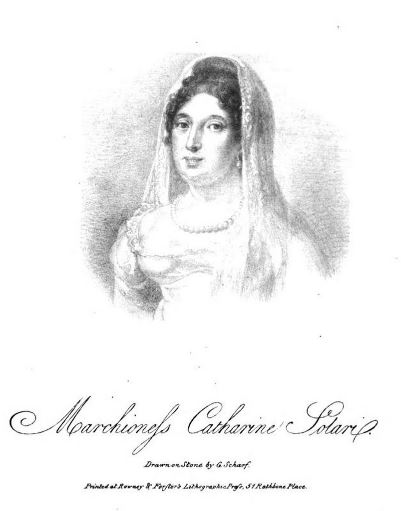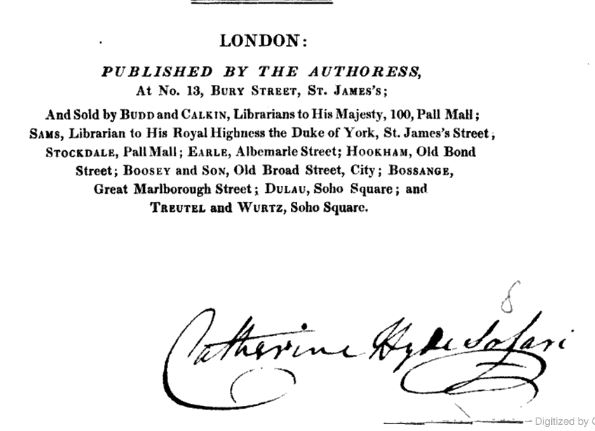29 Oct 2016: Communities of Authorship Update: The Marchioness Solari and the Royal Literary Fund
This post is the second of a series of profiles in which Dr Benjamin Colbert will feature a travel writer and her work from Women’s Travel Writing, 1780-1840, as well as an update on the research underway for the British Academy project, Women's Travel Writing: Communities of Authorship.
No. 2: Catherine Hyde (or Hyams), Marchioness Govion Broglio Solari, c. 1755-1844.
From the 39 items making up the Royal Literary Fund’s record (Loan RLF 1/435) of its dealings with the travel writer and memoirist Catherine Hyde, Marchioness Govion Broglio Solari (c1755-1844), there emerges a portrait of the artist that is consistent with self-representations in her published works, yet also details her day-to-day struggle 
The letters from both sides tell us a good deal about Solari’s publications and plans for publication, her supporters among the bookselling community, her sense of grievance at being a titled member of the aristocracy down on her luck and forced to plead for subsistence. The story she rehearses to the committee seems fantastical (and, as we shall see, may very well be so). The daughter of a scion of the Clarendon family and a mother related to the Polish royal family, she was sent to France at 11 to receive a convent education, her musical talents attracting the attention of Marie Antoinette and her confidante, the Princess Lamballe, for whom she became a Maid of Honour. Entrusted with the Princess’s journals, Solari was bundled off to Italy when the French Revolution erupted, learning of her patrons’ executions second hand. In Italy she met a Venetian nobleman, the Marquis Solari, who became her husband, but who lost his fortune after the French invasion of Italy and Napoleon’s subsequent abolition of entailed estates. Separated from her husband by Napoleon’s persecutions and forced to flee Venice by boat, she was shipwrecked and returned to England penniless, supporting herself by her literary talents. Her just deserts (she continued to claim that the Austrian government owed her compensation of above £100,000 for her husband’s confiscated estates), her English patriotism (instanced by her pamphlet on Wellington), her infirmities and failing eyesight, became the refrains of her frequent appeals to the committee.
Perhaps understandably, the committee showed signs of charity fatigue, and refusals of assistance became more common than the small sums at times voted for her. Then on 1 November 1832 came a renewed campaign from an unexpected quarter. The RLF received a letter on Solari’s behalf from Barbara Hofland (1770-1844), the prolific children’s writer and poet who also features in the Women’s Travel Writing database for her storybook travelogues for children. Hofland informed the RLF that Solari's nephew, a Mr. Hyde, had offered her asylum in New Orleans, and that she required funding for the passage which Hofland and her friends could not supply. Having prepared the ground, Hofland then submitted the appeal itself on 12 November, again in her hand, but dictated and signed by Solari. Perhaps breathing a collective sigh of relief that the American scheme would put an end to her requests, the committee voted the sums, and received an effusive letter of thanks, this time in Solari’s own hand, dated 20 February 1833, from Liverpool on the eve of her departure.
If the RLF thought this was an end to it, they were disappointed. Whatever happened in New Orleans, the letters soliciting aid began afresh in 1836 and continued up to April 1842, two years before Solari died; the letters are silent on New Orleans and their rehearsal of Solari’s woes are eerily familiar to those that came before, but for a renewed emphasis on her age and frailty as she approached 90.
In the posthumously published Letters of the Marchioness Broglio Solari (London 1845) appears a letter that the anonymous editor dates from around 1819, and in which Solari explains more fully her family origins. Her father, she says, was George Augustus Hyde, son of the diplomatist Lord Hyde Clarendon who privately married a Polish princess. Following in his father’s footsteps, George Augustus also came to reside in Poland where he became attached to a Countess, sister of the future sovereign of Poland. Their marriage depended on her divorcing, but before this could be accomplished she became pregnant with Solari, removed to Bath in England, and gave birth at the home of her Jewish servant’s father, Moses Hyams, whose wife was herself delivered at the same time of an infant who died. In the next letter, Solari explains how her mother was forced back to Poland, her father assassinated, and how she was raised as one of the Hyams’ own children, and taken for one of them (even by Mrs Hymans who was not aware that Solari and her deceased infant had been exchanged).
Those who have tested this and other Solari stories find them as implausible as they sound. A. F. Pollard, for example, in his review of Solari’s Secret Memoirs […] of the Princess Lamballe (English Historical Review 10.39 (July 1895): 588-91), argues that no such genealogy of the Hyde/Clarendon family exists or could exist, let alone the Polish princesses involved in the tale. Descendants of Moses Hyams – one of whose immediate children, Samuel Myers Hyams (1766-1843) moved to Lousiana and fathered the future Lieutenant-Governor of the state, Henry M. Hyams (1806-1875) – claim to have seen a biographical memorandum written by the Lieutenant-Governor stating that Solari was his father’s sister, born in Ireland (not Bath), and who visited her brother Samuel Hyams (not her ‘nephew’ Mr Hyde) in New Orleans at the age of 86 [c.1841]. While the RLF evidence points to a slightly earlier date for the visit, the strong possibility remains that ‘Kitty Hyams’ was not the descendant of English monarchs, but of an Irish Jew who relocated to London and, according to reports in the London newspapers, suffered anti-semitic slurs, financial ruin, and imprisonment for debt, a fate that his ‘daughter’ would have understood only too well.


